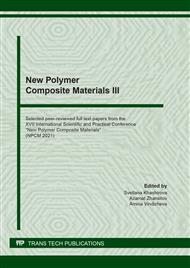p.104
p.110
p.119
p.125
p.132
p.137
p.144
p.150
p.158
Study of the Resistance of PVC Composite Materials Modified with Wollastonite Activated by QAS to Bacteria
Abstract:
Evaluation of the antibacterial properties of PVC materials used, in particular, in medicine, is becoming increasingly important due to increased sanitary and hygienic requirements. One of the ways to ensure the resistance of PVC materials to microorganisms is modification with wollastonite, the surface of which is activated by quaternary ammonium salts (QASs). QASs are known for their antimicrobial properties. The results obtained indicate that the basic composition of linoleum is somewhat more resistant to gram-positive bacteria than to gram-negative bacteria. The introduction of wollastonite into the PVC compound formulation increases the resistance to the studied groups of microorganisms. It can be concluded that the surface treatment of Mivoll 10-97 by QAS generally improves the bactericidal properties of the material. The results obtained are consistent with the literature data on the activity of cationic QACs in relation to gram-positive and gram-negative bacteria. Quaternary ammonium salts have the ability to be attracted to the outer surface of the negatively charged bacterial membrane due to the positive charge of their molecules.
Info:
Periodical:
Pages:
132-136
Citation:
Online since:
September 2021
Price:
Сopyright:
© 2021 Trans Tech Publications Ltd. All Rights Reserved
Share:
Citation:


